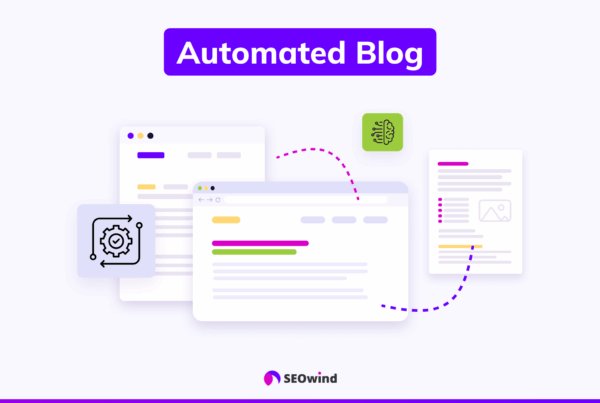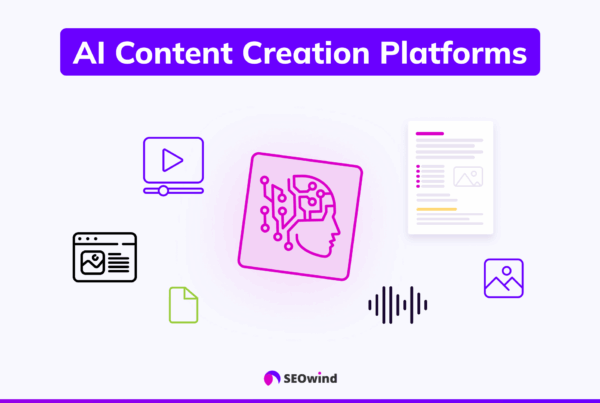The digital landscape is changing faster than ever before. With the rise of AI, what worked for SEO yesterday might not cut it today. Imagine a world where search engines don’t just find websites but actually understand them. That’s the reality AI overviews are creating. They offer a whole new way for your audience to discover you through the essence of your content.
This isn’t about throwing out your old SEO playbook but leveling up your game. In this article, we’ll thoroughly examine AI overviews, break down how they work, and offer practical tips to help you come out on top. Ready to future-proof your online presence? Let’s get started.
Understanding AI Overviews and SEO Evolution
The way users interact with search engines and the way those search engines deliver information are transforming. To truly grasp the importance of AI overviews, we must first understand how we got here.
What is AI Overview?
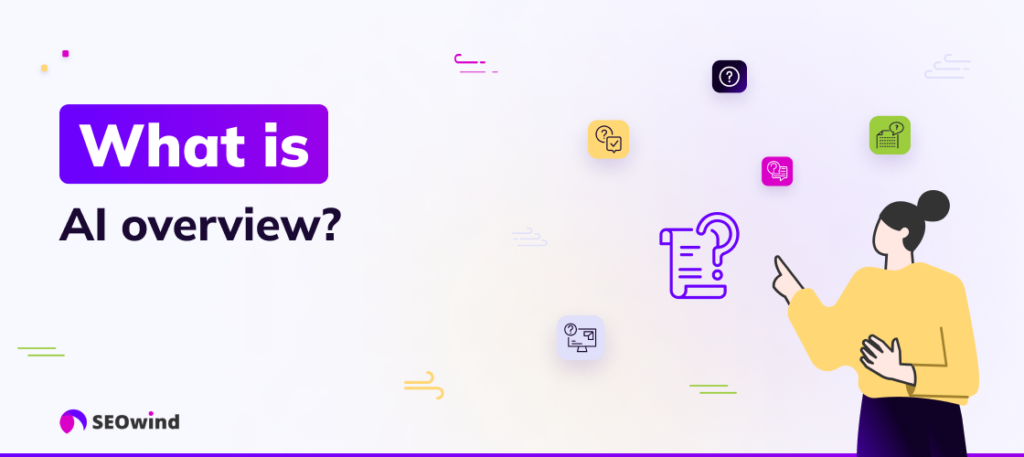
Google AI Overview is a feature that summarizes information at the top of search results. It aims to give you a quick understanding of a topic, along with links for further exploration. While still under development, it’s been used billions of times and is expected to reach over a billion users by the end of 2024.
Differentiating SEO from Generative Engine Optimization
Remember when SEO was all about keywords? While they are still relevant, we’re transitioning from traditional SEO to something more sophisticated: Generative Engine Optimization (GEO). SEO was primarily about optimizing your website so search engine crawlers could understand and rank your content based on specific keywords. On the other hand, GEO is all about optimizing your content for AI. It’s about creating valuable and well-structured content that AI engines want to feature in their overviews.
The Emergence of AI in Search: From Basics to AI Overviews
Think about the evolution of search engines. We started with basic keyword matching. Then came algorithms like Google’s PageRank, which factored in backlinks to determine website authority. Now, with AI, we’re entering a new era where search engines are becoming more conversational, intuitive, and focused on delivering comprehensive answers rather than just a list of links.
AI overviews represent a significant leap forward. These AI-generated curated summaries provide users with concise and informative answers to their queries, often without needing to click through to individual websites.
Why Embracing AI Overviews is Crucial for Future SEO
You might think, “If AI provides answers directly, won’t that hurt my website traffic?” Here’s the catch: early adoption and optimization for AI overviews can give your business a competitive advantage in search rankings and visibility. Being featured in an AI overview instantly boosts your credibility. This indicates that you’re a trusted source of information, the go-to expert on a topic. This can lead to increased brand visibility, higher click-through rates, and, ultimately, more organic traffic. Ignoring AI overviews is like ignoring the rise of social media or mobile browsing – you risk getting left behind.
AI Overviews Errors
As of June 2024, Google AI Overview has gained a lot of negative mainstream media coverage as people have been sharing numerous examples of AI Overview fails on social media. Even if Generative AI is experimental still, it should be no excuse for providing incorrect, misleading, and even dangerous answers. Below are some examples.
Still, as this AI Overview is likely to stay, and I believe Google will soon fix the issues, it’s worth getting yourself prepared for how to rank on it.
Key Strategies for Ranking in AI Overviews
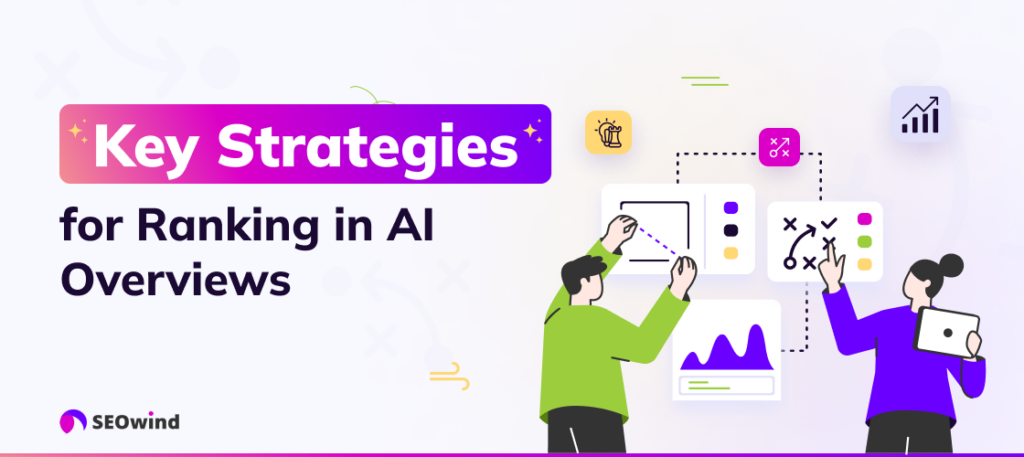
Now that we’ve established the nature of AI overviews and why they matter, let’s discuss how to make your website stand out and secure a coveted spot. This isn’t about quick fixes; you’ll need to build a digital presence so robust and relevant that AI takes notice. It’s like building a lighthouse in the digital ocean; you want that beacon to shine brightly so that the AI guides users your way.
This new landscape requires a shift in perspective as we move from a traditional keyword-centric approach to a more holistic strategy. We’re looking to deeply understand user intent and deliver relevant content that positions you as an authoritative voice. Let’s explore some strategies to help you navigate this exciting frontier:
Strategy 1: Create High-Quality, Authoritative Content

It probably won’t surprise you that creating high-quality content is paramount for ranking in AI overviews. But what does “high-quality” mean in this context, and how does it relate to AI overviews?
Let’s unpack this.
Imagine yourself as a Google user. You’re more likely to trust a comprehensive, well-researched article from a recognized source than a hastily written blog post with surface-level information, right? Well, AI overviews operate on a similar principle. Google’s algorithms are designed to identify and prioritize content that demonstrates authority, depth, and trustworthiness.
High-quality, relevant content, proper keyword use, and a well-structured website continue to play pivotal roles in visibility and ranking. Your content should go beyond targeting keywords; it needs to comprehensively address a topic, provide valuable insights, and answer user search intent thoroughly. This means investing time in research, crafting compelling narratives, and backing up your claims with credible sources.
Think of it as building a reputation for your content. The more authoritative your content is, the more likely it is to be featured in AI overviews, which ultimately boosts visibility and drives organic traffic to your website. Tools like SEOwind can be invaluable by offering AI-powered assistance for keyword research, content outlines, and even drafting to help you consistently and efficiently create high-quality content.
Strategy 2: Include thought leadership content

Thought leadership content can be incredibly valuable, especially in the age of AI. Think of it as a way to establish your brand as a go-to source in your industry. By offering unique insights, compelling perspectives, and valuable information that goes beyond the basics, you position yourself as an authority on the topic.
This approach attracts readers and encourages them to share your content. When others see your brand as a source of expertise, they’re more likely to trust your recommendations and, ultimately, choose your products or services. So, how do you create thought leadership content that resonates with users?
- Focus on originality: Instead of rehashing existing ideas, strive to bring something fresh to the table. Conduct original research, share unique case studies, or offer a contrarian viewpoint.
- Address industry pain points: What are your target audience’s biggest challenges? Providing solutions or insights into these issues demonstrates a deep understanding of your field.
- Share your vision for the future: Don’t be afraid to speculate on where your industry is headed. By painting a compelling picture of what’s to come, you can generate excitement and establish your brand as an innovator.
Remember, the goal is to provide genuine value to your audience. By offering insightful and thought-provoking content, you can position yourself as a leader in your field and reap the rewards of increased visibility, trust, and business growth. As the saying goes, “Content is king, but thought leadership is the kingdom.”
Strategy 3: Implement Structured Data to Enhance Discovery

Imagine you’re trying to find a specific recipe in a cookbook. It’s filled with beautiful pictures and engaging stories but doesn’t have a table of contents or an index. Frustrating, right? That’s precisely how search engines feel without structured data.
Structured data is the web’s unsung hero. It’s a standardized format for providing information about a page and classifying its content. Adding structured data markup to your website makes it easier for search engines to decipher and include your content in relevant AI overviews.
Structured data gives you a direct line to Google to clearly explain what your content is about and why it’s relevant to specific search queries. This clarity helps boost your chances of appearing in AI overviews and increases the likelihood of attracting your target audience.
Strategy 4: Utilize Semantic Annotation for Topic Relevance

Let’s say you’ve just baked a fantastic cake. It’s a triple-chocolate masterpiece with layers of mousse and a delicate ganache drizzle. Now, you want to share this creation with the world (or at least your neighbors!). You wouldn’t just put it on your doorstep with a plain sign that says “cake,” right? You’d want to provide more context.
Think of semantic annotation as that detailed cake description for search engines. It’s how you tell Google, “Hey, this content isn’t just about any cake; it’s a decadent chocolate cake perfect for birthdays or special occasions.”
In the context of AI overviews, semantic annotation helps search engines understand the finer points of your content. It goes beyond basic keywords to establish relationships between various concepts. This means using schema markup – a standardized vocabulary – to label different elements on your page. For example, you can specify that a particular piece of text refers to a “recipe,” “ingredient,” or “cooking time.”
This is important for AI overviews because AI aims to deliver precise, relevant information. By using semantic annotation, you provide context and clarity, making it easier for AI algorithms to identify your content’s core topic and rank it accordingly.
Strategy 5: Leverage Multimedia for Enhanced User Engagement

Let’s be real: who wants to stare at a wall of text? In today’s digital world, it’s all about grabbing attention and keeping it. That’s precisely what multimedia assets do.
Picture yourself searching for information on AI overviews. You see two results: one with plain text and the other with an eye-catching image and a short, engaging video explaining the concept. Which one are you clicking on? Almost certainly the one with multimedia.
People love visuals. Images, videos, infographics, and audio clips can make your content more digestible and memorable. They break up the monotony of text and cater to different learning styles.
But here’s the kicker: multimedia doesn’t just appeal to your audience; it appeals to AI algorithms, too.
How? Well, when you incorporate multimedia, it signals to search engines that you’ve put effort into creating a comprehensive and engaging experience for your users. This can lead to higher rankings, especially in AI overviews that prioritize user satisfaction.
And short-form videos represent another exciting trend. Remember what I said about grabbing attention? Platforms like YouTube Shorts are gaining traction, and Google will likely give them more prominence in search results.
My advice? Jump on this trend! Repurpose your content into bite-sized videos that pack a punch. It’s a fantastic way to engage your audience and increase your chances of ranking in AI overviews.
Strategy 6: Voice Search Optimization: Meeting Modern User Demands

The way people search has drastically changed with the rise of voice assistants like Siri, Alexa, and Google Assistant. We’ve gone from typing clunky keywords into a search bar to talking to our devices, asking questions in a natural, conversational language. This shift in user behavior has significant implications for how we approach SEO, particularly regarding AI Overviews.
When you use voice search, you’re not thinking about keywords. You’re asking questions. For marketers, this means we need to start optimizing our content for voice search and focusing on how people speak naturally. Instead of targeting “best AI tools,” consider how someone might phrase this question conversationally. They might ask, “What are the top AI tools available today?”.
By adapting your content to mirror this conversational style, you make it more likely that your site will be the answer to a user’s spoken query. This is where long-tail keywords—longer, more specific phrases that reflect natural language patterns—come into play. For instance, “AI tools for content creation in marketing” is far more targeted and conversational than simply “AI tools.”
Integrating FAQs into your content is another effective strategy. When someone uses voice search, they often phrase their queries as questions. By including a dedicated FAQ section that directly addresses these potential questions, you provide concise, easily digestible answers that align perfectly with the voice search format.
Strategy 7: Monitor and Adjust

Think of AI overviews as living, breathing entities. They’re constantly changing and evolving! Therefore, it’s essential to monitor your website’s performance regularly and adapt your strategies accordingly. You must keep your finger on the pulse to ensure visibility and relevance.
Now, you might be wondering, “What should I track, and how often?” Start by closely monitoring your website’s rankings for relevant keywords in AI overviews. Keep a keen eye on your click-through rates. Are people actually clicking through to your content? Analyze your website traffic to see whether it is coming from AI overviews. Utilize analytics tools like Google Search Console and Google Analytics for these purposes. These platforms provide invaluable insights into your website’s performance in search results.
But it doesn’t end there. The digital realm is dynamic, and AI overviews are no exception. Regularly review and update your content based on these insights to ensure it remains relevant and aligned with user search intent. Consider A/B testing different versions of your content or experimenting with various multimedia elements to see what resonates best with your audience. The goal is to stay agile and adaptable! Remember, consistent monitoring and adjustment are vital for achieving sustainable success in the dynamic world of AI-driven searches!
Strategy 8: Thinking Beyond Keywords: Topic Authority and Relevance

Remember when you’d stuff your content with keywords, hoping to rank higher? Those days are fading fast. Now, it’s all about becoming an authority on a topic. Think of it like this: instead of just knowing the words to a song, you understand the music, the lyrics, the artist’s story, and its cultural impact. That’s topic authority!
Building Topic Authority through Semantic Consistency
Imagine you’re writing about coffee. You wouldn’t just repeat “coffee” a hundred times. You’d talk about different brewing methods, origins, roasts, flavors, and even the cultural significance of coffee. This tells Google that you’re building a comprehensive understanding of the topic rather than just matching keywords.
The key here is semantic consistency. Use related terms and concepts naturally throughout your content. Instead of just “coffee,” weave in words like “espresso,” “French press,” “Arabica beans,” and “caffeine.” This creates a web of meaning around your core topic, making it clear to search engines (and readers!) that you know your stuff.
Understanding the Role of Links in Topic Identification
Links are like bridges connecting different pieces of information. When you link to high-quality, relevant sources, you’re not just sending traffic their way; you’re also signaling to search engines what your content is about.
For instance, if you write about AI overviews and link to resources like Google’s AI blog or reputable research papers on the subject, it strengthens your content’s relevance to search algorithms.
You’re part of a conversation. Citing your sources and linking to valuable resources shows you’ve done your research and are contributing meaningfully to the discussion. This boosts your credibility and helps search engines understand the context and depth of your content.
Strategy 9: Make Your Brand Well-Known

You’ve crafted exceptional content, optimized it for AI overviews, and are ready to climb those search rankings. But hold on! There’s another vital piece of the puzzle: brand awareness.
When you search for running shoes, you’re more likely to click on a familiar brand like Nike or Adidas, right? And why is that? Because you already trust their quality and reputation.
The same applies to AI overviews. A well-known brand is more likely to attract clicks and engagement because it informs search engines of its authority and relevance. So, how do you increase your brand’s visibility in the vast digital landscape? Let’s explore some proven strategies:
- Public Relations: A robust PR strategy can boost your brand’s visibility. Issue press releases for significant company updates, secure guest posts on prominent industry blogs, and actively participate in relevant online forums and communities.
- Social Media Presence: Establish an active presence on platforms where your target audience hangs out. Share engaging content, interact with your followers, and run targeted ad campaigns to reach a broader audience. Remember, consistency is key!
- Influencer Marketing: Collaborate with influential figures in your niche. Having them recommend or review your brand can significantly impact brand awareness and drive traffic to your site.
- Content Marketing (Beyond Blog Posts): Diversify your content beyond traditional blog posts. Explore other formats like ebooks, white papers, webinars, and podcasts. Offering valuable, free resources can establish you as a thought leader and attract a wider audience.
By integrating these strategies, you can boost your brand’s visibility, ensuring your exceptional content reaches a broader audience. This increased exposure drives traffic and builds trust and authority, crucial factors for ranking in AI overviews and dominating the search landscape.
Strategy 10: Diversify your content types

In the world of digital content, variety is the spice of life. You can’t expect to keep your audience engaged if you keep serving them the same old plain text, right? That’s where content diversification comes in. Think of it as setting up a buffet for your audience; you want to offer something for everyone to keep them coming back for more.
Enrich MoFu content – interactive content quizzes, calculators, demos, free trials
Middle-of-the-funnel (MoFu) content is how you start reeling your audience in further. They’ve shown interest and are now looking for more engaging, valuable interactions. This is your chance to get creative! Interactive content like quizzes and calculators can be incredibly effective. For instance, imagine you’re in the financial services industry. Offering a “mortgage calculator” provides value to potential customers and positions your brand as knowledgeable and helpful. Demos and free trials are another excellent way to let potential customers experience your product or service firsthand. This hands-on approach can be far more convincing than simply reading about it.
Leverage BoFu content – email campaigns, product comparisons, online classes
As you move toward the bottom of the funnel (BoFu), your content should nudge your audience to make a decision. This is where you present them with targeted, high-value content that helps them make an informed choice. Well-crafted email campaigns that offer exclusive deals or insights can be very persuasive. Similarly, providing detailed product comparisons can help those final-stage prospects weigh their options. Don’t underestimate the power of online classes or webinars. These can position your brand as an authority in your field while delivering immense value to potential customers.
Mix text with video and visual content
Nobody wants to stare at a wall of text. Break up your content and make it visually appealing by incorporating videos and images. A well-produced video can explain a complex topic in minutes, while infographics can present data in an easy-to-digest manner. Remember, visual content is often more shareable, extending your reach and potentially bringing in a broader audience. Think about using tools like SEOwind to streamline the process of creating engaging, SEO-optimized content across different formats. By diversifying your content and leveraging a mix of text, video, and visuals, you’ll deliver a more engaging and immersive experience for your audience, increasing their time spent on your site and improving your chances of ranking in AI overviews.
Strategy 11: Improve the User Experience

Let’s be honest, nobody enjoys waiting for a slow website to load (Very repetitive. Rewrite this line). In today’s fast-paced digital world, a slow website can be the difference between attracting a new customer and losing them to a competitor.
Think about your own browsing habits for a second. How often do you patiently wait for a page to load? If it takes more than a couple of seconds, you probably abandon the page and move on. It’s the same for everyone else.
Now, consider how this translates to AI overviews. Google wants to offer its users the best possible experience, which means showcasing informative, relevant, and easily accessible content. A website that loads slowly won’t make the cut.
So, what can you do? Prioritize website speed and simplicity. Here’s how:
- Optimize your website’s loading speed: There are many tools and techniques available to improve your site’s performance. Consider compressing images, leveraging browser caching, and minimizing unnecessary scripts.
- Ensure mobile-friendliness: With a significant portion of internet traffic coming from mobile devices, having a responsive website is crucial. A mobile-friendly design adapts seamlessly to different screen sizes, offering users a consistent experience across devices.
- Simplify your website’s navigation: Make it easy for users to find what they want. Use clear and concise menus, intuitive site architecture, and prominent search functionality. A well-organized website keeps users engaged and encourages them to explore further.
- Use clear and concise language: Your goal is to communicate effectively, not to impress people with jargon. Use language that’s easy to understand and avoids unnecessary complexity. Simple language leads to better comprehension and a more positive user experience.
Focusing on the user experience enhances your website’s visibility in AI overviews and creates a positive impression for your visitors. This translates to increased engagement, higher conversion rates, and a stronger online presence.
Strategy 12: Build a Strong Backlink Profile to Boost Credibility

Backlinks are effectively votes of confidence from one website to another. When a reputable website links to your content, this signals to search engines like Google that the material is valuable and trustworthy. This trust, reflected through a strong backlink profile, can significantly enhance your visibility in AI overviews.
A robust backlink profile tells Google that your site has authority and provides valuable information, making it more likely to appear in those coveted AI overview spots. Let’s say you’re writing a research paper. You wouldn’t just rely on information from obscure sources, right? You’d seek out respected journals and authors. Backlinks work similarly, adding credibility to your site in the eyes of search engines.
The Technical Side: Enhancing Visibility through GEO
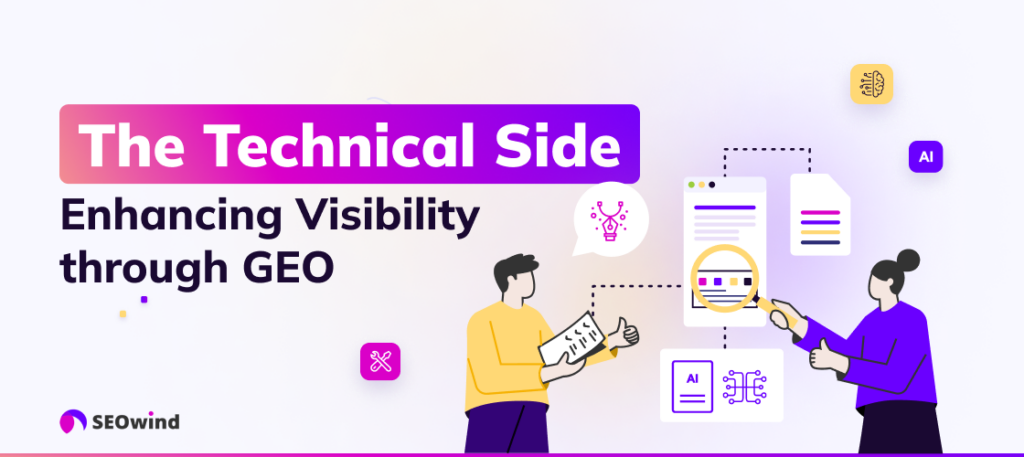
Introduction to GEO
Now that we’ve explored the strategic landscape of ranking in AI overviews, let’s dive into the technical side of things. GEO is specifically designed to help you stand out in the age of AI-powered search results.
While traditional SEO focuses on optimizing for search engine crawlers, GEO takes it a step further. This approach optimizes your content to cater to the powerful AI algorithms that curate those coveted spots in AI overviews.
Critical Features of GEO and Its Impact on AI Overviews
So, what makes GEO tick? What are the nuts and bolts that make it so effective for AI overviews?
- Structured Data Markup: Remember how we talked about speaking AI’s language? Structured data markup is like handing the algorithm a neatly organized dictionary of your content. It helps AI instantly grasp the context, relationships, and critical elements within your website, making it easier to be selected for relevant AI overviews.
- Semantic Relevance: It’s not just about keywords anymore; you need to understand their meaning and intent. GEO emphasizes creating content that demonstrates a deep understanding of a topic, using related terms and concepts to paint a comprehensive picture for the AI.
- Content Quality and Originality: AI is getting incredibly smart at sniffing out low-quality, regurgitated content. GEO stresses the importance of producing fresh, insightful, and original material that establishes your authority and trustworthiness, qualities AI values highly.
By focusing on these elements, GEO empowers your content to shine brightly in the eyes of AI algorithms, significantly boosting your chances of landing prime real estate in AI overviews.
Measuring SEO and GEO Success
Measuring the success of your GEO efforts is as crucial as the efforts themselves. While traditional SEO relies heavily on metrics like keyword rankings and backlinks, GEO demands a broader perspective. Here’s a glimpse into the metrics that matter:
- Appearance in AI overviews: The most direct measure of GEO success is how frequently your site appears in relevant AI overviews. Are you consistently featured? That’s a strong indicator of effective GEO.
- Click-Through Rate (CTR) from AI overviews: It’s not enough to appear; you want users to be captivated by your snippets and eager to learn more. A high CTR from your AI overview listings signals that your content resonates with the audience.
- Engagement Metrics: Once users land on your site from an AI overview, how do they interact with your content? Are they staying engaged, exploring further, or bouncing back to the search results? Metrics like bounce rate, time on page, and pages per session offer valuable insights into the effectiveness of your GEO-optimized content.
By diligently tracking these metrics, you can fine-tune your GEO strategies and ensure that your content consistently captures the attention of AI algorithms and eager users alike.
Sourcing and Structuring Information for AI Overviews
Ever wondered how Google decides which websites are worthy of a coveted spot in their AI overviews? It’s like trying to guess the winning lottery numbers, right? Well, not exactly. Let’s pull back the curtain and uncover the secret sauce behind getting featured in AI overviews.
What Triggers Inclusion in AI Overviews?
Here’s the thing: Google’s AI is smart. Like, really smart. It has a knack for sniffing out websites that are chock-full of valuable, relevant, and trustworthy information. Think of it as a digital librarian who can quickly scan through a mountain of books to find the ones with the most insightful and credible answers to your questions.
So, what makes your content stand out? Imagine you’re searching for information about “the impact of climate change.” Google’s AI is more likely to pull information from websites:
- Belonging to reputable organizations: Think government agencies, research institutions, or well-established news sources. It’s like trusting a seasoned professor over someone who just googled the topic.
- Showcasing in-depth analysis and research: Articles backed by data, studies, and expert insights are pure gold. Would you trust a random blog post or a well-researched report from a leading scientific journal?
- Demonstrating clear expertise in the field: Websites consistently publishing high-quality content related to climate change will gain more visibility.
Auto-Inclusion Explained: How Sites Get Picked for AI Overviews
So, do you need to submit your website somewhere to be considered? The good news is that there’s no fancy application process. Google’s AI constantly crawls and indexes the web, looking for the best and most relevant content. It’s like having a team of tireless explorers on a mission to discover hidden gems of information.
This process of automatic inclusion, often called organic searching, is all about consistently putting out stellar content. Focus on these key ingredients, and you’ll increase your chances of getting noticed:
- Clarity and conciseness: Make sure your writing is easy to understand, even for someone new to the topic.
- Engaging and informative: Keep readers hooked with well-structured content, compelling storytelling, and valuable insights.
- Up-to-date and accurate: Nobody wants outdated information! Keep your content fresh and relevant to stay ahead of the search game.
Your website is like a constantly evolving library of knowledge. By consistently adding valuable and well-structured information, you’re sending signals to Google’s AI that you are a go-to source in your field.
Staying Ahead: Continuous Learning and Adaptation

The Importance of Google’s SEO Documentation on AI Overviews
Think of Google’s SEO documentation provides invaluable insights into how to navigate this new territory. By staying informed about Google’s evolving algorithms and best practices, you equip yourself with the knowledge to adapt your content strategy accordingly. Regularly consulting their guidelines ensures that you remain aligned with their recommendations, maximizing your chances of ranking well.
The Always-On Mentality for Staying Relevant
When it comes to AI, standing still means falling behind. The algorithms powering AI overviews are continuously learning and evolving, which means your strategies must, too. Embrace an “always-on” mentality by staying curious and adaptable. This involves:
- Actively monitoring industry trends.
- Experimenting with new content formats.
- Refining your approach based on performance data.
Think of it as a continuous feedback loop in which you constantly learn, adapt, and improve your content to stay ahead of the curve.
FAQs about AI overviews
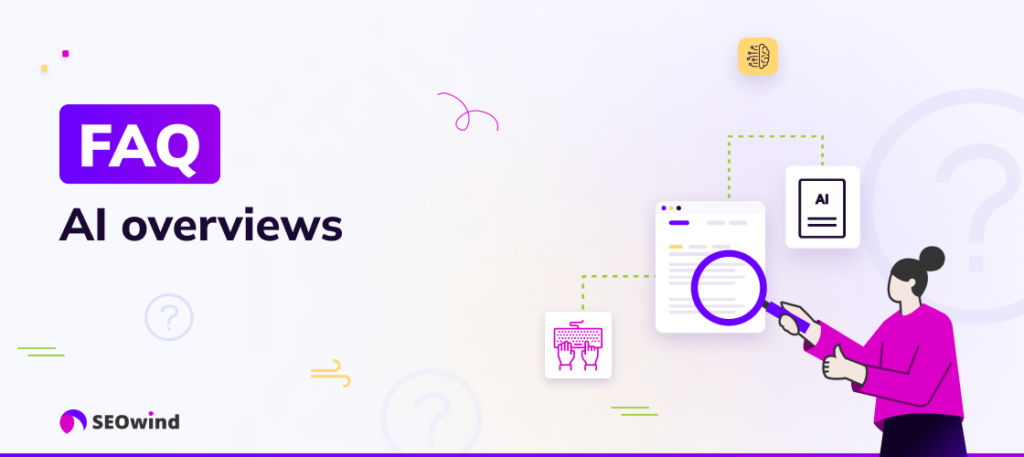
How Do SEO and GEO Work Together in the Context of AI Overviews?
Think of SEO and GEO as two sides of the same coin, which work harmoniously to improve your website’s visibility. While SEO focuses on optimizing your site for traditional search engines, GEO takes it a step further. GEO optimizes your content for AI-powered features, including those coveted AI overviews. I like to picture it this way: SEO gets your foot in the door, while GEO helps you steal the show!
SEO ensures your website is discoverable by search engine crawlers. This means using relevant keywords, building a solid backlink profile, and creating high-quality content. GEO then ensures your content is structured and formatted so AI can easily understand and utilize it.
Can AI Overviews and Traditional Search Coexist?
Absolutely! It’s not a case of one replacing the other. Instead, they’re complementary forces. Traditional search, powered by keywords and backlinks, remains relevant for users with specific search intents.
Meanwhile, AI overviews cater to a broader audience. They’re particularly helpful for those who are exploring a topic. Imagine someone new to AI researching “Benefits of AI in Healthcare.” An AI overview provides a concise summary of key points. It draws from various authoritative sources and offers users a valuable starting point in their exploration.
Strategies for Monitoring and Adapting to Changes in AI Overview Rankings
The digital world is in constant flux, and AI is no exception! Staying ahead of the curve requires vigilance and adaptability. Begin by tracking which pages on your website appear in AI overviews and analyzing their performance. Are they attracting traffic? Are users engaging with your content?
Utilize tools to monitor keyword rankings and content performance. This data will be your compass guiding you to make necessary adjustments. Remember, continuous learning is essential. Stay informed about the latest advancements in AI and SEO to maintain a competitive edge in this dynamic landscape.
Will GEO replace SEO in the future?
GEO is full of potential, but SEO has a proven track record. While predicting the future of searching is impossible, one thing is certain: both GEO and SEO have their unique strengths.
As AI evolves, we can expect to see more sophisticated search experiences. GEO will undoubtedly play a significant role in shaping these experiences. However, the core principles of SEO, like high-quality content and user experience, will always remain relevant.
